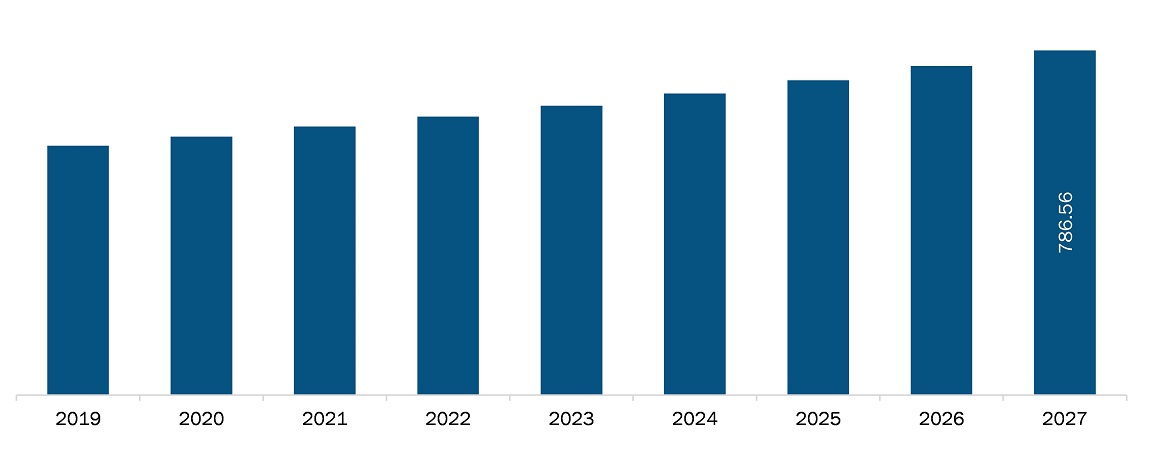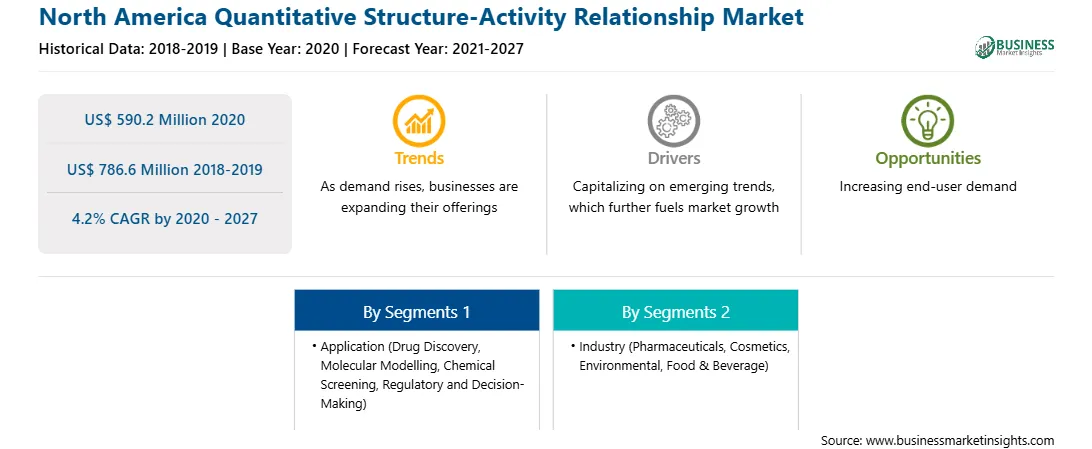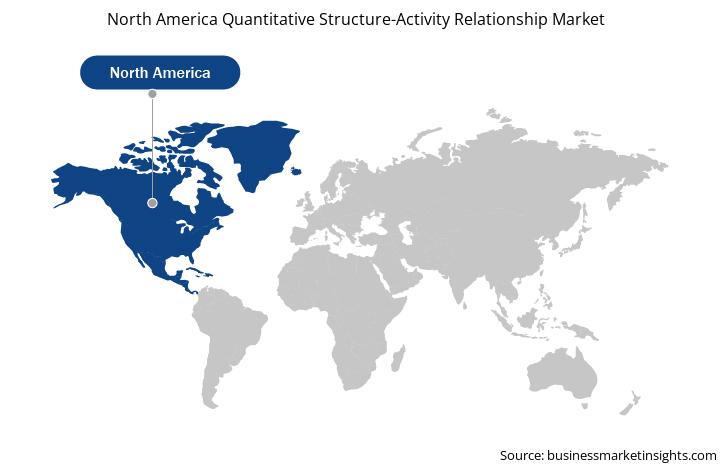A quantitative structure-activity relationship (QSAR) is a computational or mathematical modeling approach to reveal connections between biological activities and chemical compounds' structural properties. It attempts to correlate chemical structure with an activity using statistical approaches. The QSAR models are beneficial for various purposes, including the prediction of actions of untested chemicals. Also, it helps to prioritize desired biological activities as an in-silico methodology and thus decreases the number of candidate chemicals to be tested with in vivo experiments.
Thus, the increasing adoption of modeling tools in drug discovery is expected to create a significant demand for quantitative structure-activity relationships in the coming years, which is further anticipated to drive the quantitative structure-activity relationship market.
The first of the National Institute of Allergy and Infectious Diseases’ (NIAID) Covid-19 research priorities is to improve understanding of the disease and the novel coronavirus that causes it, SARS-CoV-2. This helps with understanding the transmission of the disease, including determining whether it is likely to be seasonally circulating, as well as why Covid-19 so dramatically affects some individuals, while others remain asymptomatic. But better knowledge about the virus and the disease can also support the identification of new drug targets or which existing drugs could help tackle this viral disease. Drugs are essential to stopping more suffering at the hands of Covid-19; at the time of writing, more than 461,000 people have tragically died from the disease in the US. The most critical method for anti-SARS-CoV-2 drug discovery includes the de novo development of new, specific drugs based upon the genomic and biophysical understanding of this virus. For instance, the determination of key SARS-CoV-2 targets may bring about the production of siRNA molecules or inhibitors against specific viral enzymes correlated with viral replication. The intensive vaccines and potential immunity boosting drug development procedures and ramping up of food testing services, which is expected to create a positive impact on the growth of quantitative structure-activity relationship (QSAR) market in the North American region.

Strategic insights for the North America Quantitative Structure-Activity Relationship provides data-driven analysis of the industry landscape, including current trends, key players, and regional nuances. These insights offer actionable recommendations, enabling readers to differentiate themselves from competitors by identifying untapped segments or developing unique value propositions. Leveraging data analytics, these insights help industry players anticipate the market shifts, whether investors, manufacturers, or other stakeholders. A future-oriented perspective is essential, helping stakeholders anticipate market shifts and position themselves for long-term success in this dynamic region. Ultimately, effective strategic insights empower readers to make informed decisions that drive profitability and achieve their business objectives within the market.

| Report Attribute | Details |
|---|---|
| Market size in 2020 | US$ 590.2 Million |
| Market Size by 2027 | US$ 786.6 Million |
| Global CAGR (2020 - 2027) | 4.2% |
| Historical Data | 2018-2019 |
| Forecast period | 2021-2027 |
| Segments Covered |
By Application
|
| Regions and Countries Covered | North America
|
| Market leaders and key company profiles |
The geographic scope of the North America Quantitative Structure-Activity Relationship refers to the specific areas in which a business operates and competes. Understanding local distinctions, such as diverse consumer preferences (e.g., demand for specific plug types or battery backup durations), varying economic conditions, and regulatory environments, is crucial for tailoring strategies to specific markets. Businesses can expand their reach by identifying underserved areas or adapting their offerings to meet local demands. A clear market focus allows for more effective resource allocation, targeted marketing campaigns, and better positioning against local competitors, ultimately driving growth in those targeted areas.

The quantitative structure-activity relationship market in North America is expected to grow from US$ 590.2 million in 2020 to US$ 786.6 million by 2027; it is estimated to grow at a CAGR of 4.2% from 2020 to 2027. The companies engaged in drug discovery and development are adopting various business strategies to expedite discovery timelines and improve product quality. Several players in this market are focusing on collaboration with innovative biotech companies, academics, and pharmaceutical companies to enhance their respective in silico-based service portfolio and maintain a competitive edge in the industry. Majority of the pharmaceutical companies have been benefited by adopting modelling software, which, in turn is expected to propel the growth of the quantitative structure-activity relationship (QSAR) market during the forecast period. For instance, Schrodinger’s collaboration with Agios Pharmaceuticals, Inc. resulted in two FDA approved therapies with the help of computational platform.
In terms of application, the drug discovery segment accounted for the largest share of the North America quantitative structure-activity relationship market in 2019. In terms of end user, the pharmaceuticals segment held a larger market share of the quantitative structure-activity relationship market in 2019.
A few major primary and secondary sources referred to for preparing this report on the quantitative structure-activity relationship market in North America are company websites, annual reports, financial reports, national government documents, and statistical database, among others. Major companies listed in the report are ProtoQSAR SL, Intertek Group Plc, Laboratory Corporation of America Holdings, LATHAM BIOPHARM GROUP, NSF INTERNATIONAL., and Creative Biolabs.
By Application
By End User
By Country
The North America Quantitative Structure-Activity Relationship Market is valued at US$ 590.2 Million in 2020, it is projected to reach US$ 786.6 Million by 2027.
As per our report North America Quantitative Structure-Activity Relationship Market, the market size is valued at US$ 590.2 Million in 2020, projecting it to reach US$ 786.6 Million by 2027. This translates to a CAGR of approximately 4.2% during the forecast period.
The North America Quantitative Structure-Activity Relationship Market report typically cover these key segments-
The historic period, base year, and forecast period can vary slightly depending on the specific market research report. However, for the North America Quantitative Structure-Activity Relationship Market report:
The North America Quantitative Structure-Activity Relationship Market is populated by several key players, each contributing to its growth and innovation. Some of the major players include:
The North America Quantitative Structure-Activity Relationship Market report is valuable for diverse stakeholders, including:
Essentially, anyone involved in or considering involvement in the North America Quantitative Structure-Activity Relationship Market value chain can benefit from the information contained in a comprehensive market report.